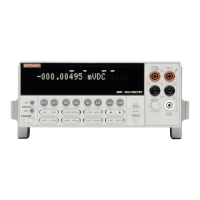IEEE-488 Reference
4-37
Byte Register. Conversely, when a standard event is unmasked (enabled), the occurrence of that
event will set the ESB bit. For information on the Standard Event Status Register and descrip-
tions of the standard event bits, see paragraph 4.10.4. The Status Byte Register is described in
paragraph 4.6.9.
A cleared bit (bit set to “0”) in the enable register will prevent (mask) the ESB bit in the Status
Byte Register from setting when the corresponding standard event occurs. A set bit (bit set to
“1”) in the enable register will allow (enable) the ESB bit to set when the corresponding standard
event occurs. For details on the status register structure, refer to paragraph 4.6.
The Standard Event Enable Register is shown in Figure 4-15. Notice that the decimal weight of
each bit is included in the illustration. The sum of the decimal weights of the bits that you wish
to be set is the value that is sent with the *ESE command. For example, to set the CME and QYE
bits of the Standard Event Enable Register, send the following command:
*ESE 36
where; CME (bit B5) = Decimal 32
QYE (bit B2) = Decimal 4
parameter = 36
If a command error (CME) occurs, bit B5 of the Standard Event Status Register will set. If a
query error (QYE) occurs, bit B2 of the Standard Event Status Register will set. Since both of
these events are unmasked (enabled), the occurrence of any one of them will cause the ESB bit
in the Status Byte Register to set.
The contents of the Standard Event Status Event Register can be read by using the *ESE? query
command (see next paragraph).
Programming Example
OUTPUT 716; “*ESE 24” ! Set bits B3 (DDE) and B4 (EXE) of the Standard Event
Enable Register.
B7 B6 B5 B4 B3 B2 B1 B0
0/1 0/1 0/1
Bit Position
Event
Decimal Weighting
Value
Value : 1 = Event Bit Set
0 = Event Bit Cleared
Events : PON = Power On
URQ = User Request
CME = Command Error
EXE = Execution Error
DDE = Device-dependent Error
QYE = Query Error
OPC = Operation Complete
PON URQ CME EXE DDE QYE OPC
0/1 0/1 0/1 0/1
(2 )
7
(2 )
6
(2 )
5
(2 )
4
(2 )
3
(2 )
2
(2 )
0
64 32 1128 16 8 4
igure 4-15
Standard Event Enable Register

